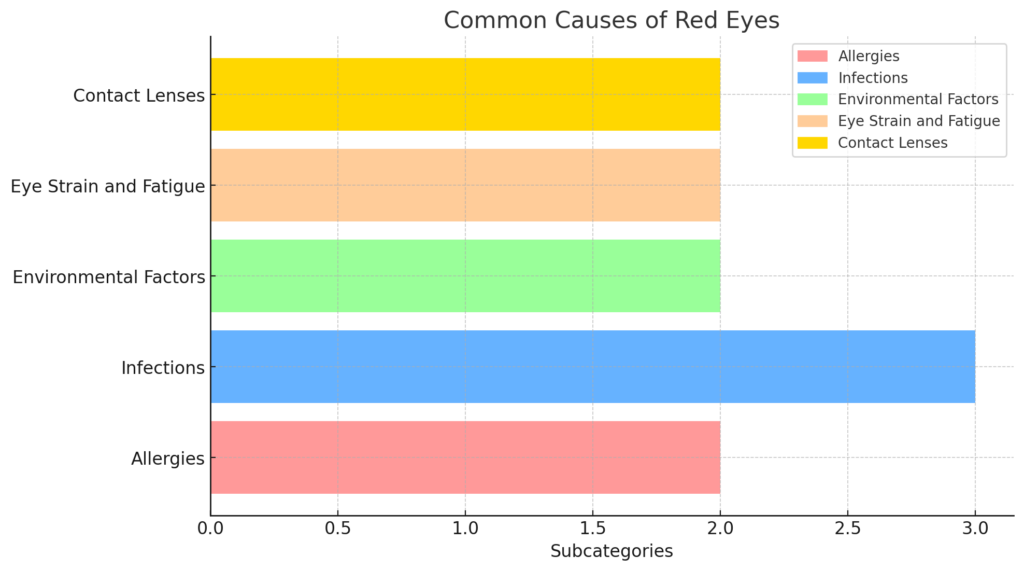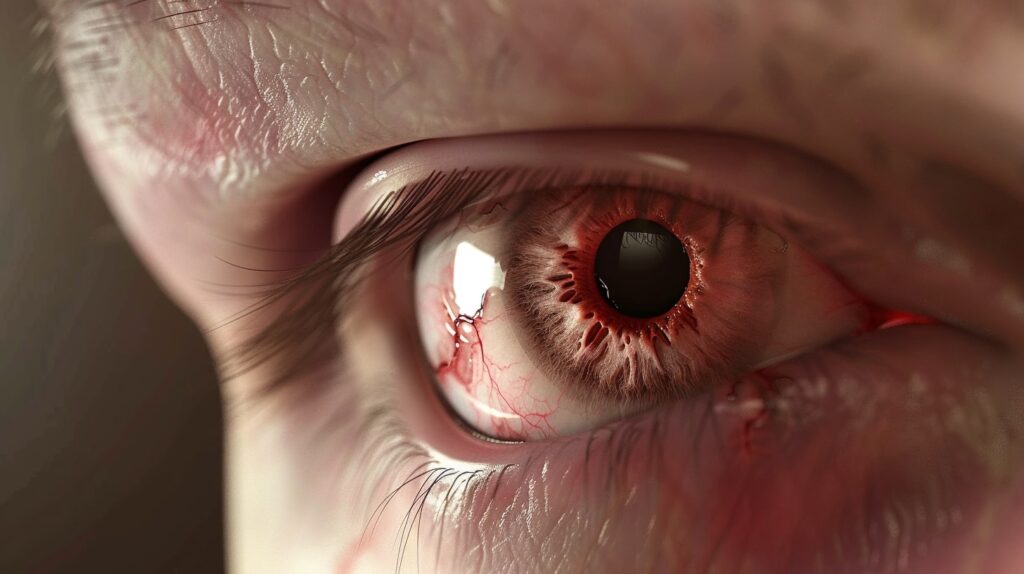Red Eyes
Ihr Leitfaden, Informationen und Tipps
ChatGPT Introduction: Understanding and Tackling Red Eyes - Your Guide to Clear and Healthy Vision
Red eyes, also known as bloodshot eyes, are a common condition affecting millions of people worldwide. According to the American Academy of Ophthalmology, nearly 1 in 5 adults experience red eyes at some point. This condition occurs when the blood vessels on the surface of the eye become dilated and congested, often due to environmental factors, infections, or lifestyle choices.
Understanding the causes and treatments for red eyes is crucial for maintaining good eye health. Red eyes can result from simple issues like lack of sleep or more serious conditions like infections. A survey by the Vision Council found that 80% of Americans experience digital eye strain, a significant contributor to red eyes, due to prolonged screen time.
In this guide, we will explore the various reasons behind red eyes, effective treatments, and practical prevention tips. We’ll cover everything from home remedies and lifestyle adjustments to innovative treatments and eye relaxation exercises. Our aim is to provide you with comprehensive insights and actionable advice to help you keep your eyes healthy and clear.
Key Takeaways of red eyes
| Category | Details |
|---|---|
| Understanding Red Eyes | Definition and symptoms of red eyes |
| Common Causes | – Allergies (seasonal, pet dander, dust mites) |
| – Infections (conjunctivitis, blepharitis, keratitis) | |
| – Environmental factors (dry air, pollution, chlorine) | |
| – Eye strain and fatigue (prolonged screen time, lack of sleep) | |
| – Contact lens issues (improper use, allergic reactions) | |
| Diagnosis | – When to see a doctor |
| – Common diagnostic procedures | |
| Treatment Options | – Home remedies (cold compresses, artificial tears) |
| – Over-the-counter medications (antihistamine drops, decongestant drops) | |
| – Prescription treatments (antibiotic drops, steroid drops) | |
| – Lifestyle adjustments (reducing screen time, improving sleep habits) | |
| Exercises and Practices for Eye Relaxation | – Eye yoga and relaxation techniques |
| – Benefits of regular eye exercises | |
| The Role of Blue Light in Eye Strain | – How blue light affects the eyes |
| – Tools and tips to minimize blue light exposure | |
| Psychological Impact of Chronic Red Eyes | – Emotional and social effects |
| – Coping strategies and support | |
| Prevention Tips | – Good hygiene practices (washing hands, avoiding touching the eyes) |
| – Proper eye care (correct use of contact lenses, regular eye exams) | |
| – Environmental control (using air purifiers, wearing protective eyewear) | |
| When to Seek Medical Attention | – Warning signs of serious conditions |
| – Importance of professional diagnosis and treatment |
What Are Red Eyes?
Red eyes, commonly referred to as bloodshot eyes, occur when the tiny blood vessels on the surface of the eye become swollen or dilated. This condition can cause the white part of the eye (the sclera) to appear pink or red. Symptoms often associated with red eyes include:
- Irritation: A feeling of grittiness or a sensation that something is in the eye.
- Itching: An urge to rub the eyes, often due to allergies or dryness.
- Discharge: Mucus or pus discharge, indicating an infection.
- Tearing: Increased tear production as a response to irritation or infection.
- Pain: Discomfort or pain, which may suggest a more serious underlying condition.
Red eyes can vary in severity from a minor cosmetic concern to a significant medical issue requiring prompt attention. It’s important to understand the underlying causes to determine the appropriate treatment and management strategies.
Common Causes of Red Eyes
Red eyes can result from a variety of causes, ranging from environmental factors to underlying health conditions. Understanding these causes can help in identifying the appropriate treatment and prevention strategies. Here are some common causes:
Allergies
- Seasonal Allergies: Pollen from trees, grass, and weeds can trigger allergic reactions, leading to red, itchy, and watery eyes.
- Pet Dander and Dust Mites: Common indoor allergens like pet dander and dust mites can cause persistent eye redness and discomfort.
Infections
- Conjunctivitis (Pink Eye): An infection or inflammation of the conjunctiva, often caused by viruses, bacteria, or allergens, leading to redness, itching, and discharge.
- Blepharitis: Inflammation of the eyelids, often associated with redness, swelling, and crusting around the eyelashes.
- Keratitis: An infection or inflammation of the cornea, which can be caused by bacteria, viruses, fungi, or parasites, leading to severe redness, pain, and vision changes.
Environmental Factors
- Dry Air and Pollution: Exposure to dry air, wind, smoke, or pollution can irritate the eyes, causing redness and dryness.
- Chlorine in Swimming Pools: Chlorinated water can irritate the eyes, leading to redness and discomfort, especially in frequent swimmers.
Eye Strain and Fatigue
- Prolonged Screen Time: Extended use of digital devices like computers, smartphones, and tablets can cause digital eye strain, leading to red, dry, and tired eyes.
- Lack of Sleep: Insufficient sleep can result in eye fatigue and redness, as the eyes do not get enough rest to recover from daily strain.
Contact Lenses
- Improper Use and Care: Wearing contact lenses for too long, not cleaning them properly, or using expired solutions can cause irritation and redness.
- Allergic Reactions: Some individuals may develop allergies to the contact lens material or the cleaning solutions, resulting in red and uncomfortable eyes.
Identifying the cause of red eyes is crucial for determining the appropriate treatment and prevention measures. If red eyes persist or are accompanied by severe symptoms, it is essential to seek medical advice for a proper diagnosis and treatment plan.

Back
Greyblue
Ravi
Sapphire Blue
„Enhance and protect the natural allure of your amber eyes with sustainable, stylish eyewear crafted from natural materials for superior comfort and UV protection.“
Diagnosing Red Eyes
Diagnosing the cause of red eyes is essential for effective treatment and prevention. Medical professionals use a variety of methods to determine the underlying issue.
When to See a Doctor
While occasional red eyes can be harmless, certain symptoms warrant professional evaluation. According to the American Academy of Ophthalmology, you should see a doctor if you experience:
- Persistent redness lasting more than a week
- Severe pain or discomfort
- Sensitivity to light
- Blurred vision
- Discharge or crusting
Common Diagnostic Procedures
Doctors typically use the following methods to diagnose red eyes:
- Patient History: Understanding the patient’s symptoms, medical history, and potential exposure to allergens or irritants is the first step. This helps in identifying patterns and possible causes.
- Visual Examination: Using a slit-lamp microscope, doctors can closely examine the eye’s surface and internal structures. This helps detect any inflammation, infection, or foreign bodies.
- Tear Production Test: The Schirmer test measures tear production to diagnose dry eyes, a common cause of redness. Small strips of paper are placed under the lower eyelids to measure the amount of moisture.
- Allergy Testing: If allergies are suspected, doctors may conduct skin or blood tests to identify specific allergens causing eye redness.
In some cases, more advanced diagnostic tools like imaging tests or cultures of eye discharge may be necessary to identify bacterial or viral infections. Accurate diagnosis is crucial for determining the appropriate treatment and ensuring optimal eye health.
Treatment Options for Red Eyes
Effective treatment of red eyes requires addressing the underlying cause. Depending on the severity and source of the redness, various treatment options are available, ranging from simple home remedies to prescription medications.
For minor cases, home remedies can be very effective. Applying a cold compress can reduce swelling and soothe irritation; studies have shown that cold compresses can significantly decrease eye redness caused by minor irritants. Over-the-counter artificial tears, which mimic natural tears, can also provide immediate relief from dryness and irritation. These are particularly beneficial for those who experience red eyes due to dry environments or prolonged screen time.
Over-the-counter medications are another option for managing red eyes. Antihistamine drops are highly effective in treating red eyes caused by allergies. They work by reducing the body’s histamine response, which is responsible for the redness and itching associated with allergic reactions. Decongestant drops, which help constrict the blood vessels on the surface of the eye, can also reduce redness. However, these should be used with caution, as overuse can lead to rebound redness, where the redness returns worse than before.
For more severe cases, prescription treatments may be necessary. If red eyes are caused by bacterial infections, such as conjunctivitis, antibiotic eye drops can effectively clear the infection and reduce redness. According to the Centers for Disease Control and Prevention (CDC), bacterial conjunctivitis accounts for a significant number of red eye cases annually, and prompt antibiotic treatment can prevent complications. In cases of significant inflammation, steroid eye drops may be prescribed to reduce swelling and redness. It is crucial to use these under medical supervision due to potential side effects, including increased intraocular pressure and cataract formation.
Lifestyle adjustments can also play a crucial role in managing red eyes. Reducing screen time and taking regular breaks can help prevent digital eye strain, which the Vision Council identifies as a growing issue, with 80% of Americans experiencing symptoms related to prolonged screen use. Implementing the 20-20-20 rule—every 20 minutes, look at something 20 feet away for at least 20 seconds—can alleviate this strain. Additionally, improving sleep habits is essential; research indicates that 7-8 hours of sleep per night can reduce eye fatigue and redness, promoting overall eye health.
These treatment options, when tailored to the individual’s specific condition, can provide significant relief from red eyes. However, if symptoms persist or worsen, seeking professional medical advice is crucial to ensure a comprehensive and effective treatment plan.
Exercises and Practices for Eye Relaxation
Incorporating exercises and relaxation techniques into your daily routine can significantly reduce eye strain and prevent red eyes. Regular practice can improve eye health and overall well-being.
Eye Yoga and Relaxation Techniques
Eye yoga involves simple exercises designed to reduce eye strain and improve eye health. Techniques such as palming, where you gently cup your hands over your closed eyes without applying pressure, can help relax the eye muscles. Another effective exercise is focusing on a near object for a few seconds, then shifting your focus to a distant object. This practice helps strengthen the eye muscles and reduce strain.
Benefits of Regular Eye Exercises
Regular eye exercises offer numerous benefits. Studies have shown that eye exercises can improve focus, reduce eye strain, and alleviate symptoms of digital eye strain. For instance, the American Optometric Association suggests that performing eye exercises for a few minutes each day can help maintain healthy vision and reduce the risk of developing chronic eye conditions.
The Role of Blue Light in Eye Strain
With the increasing use of digital devices, exposure to blue light has become a significant concern for eye health. Understanding how blue light affects the eyes and implementing strategies to minimize its impact is essential.
How Blue Light Affects the Eyes
Blue light, emitted by screens and digital devices, can penetrate deep into the eye and potentially cause damage to the retina. Prolonged exposure to blue light can lead to digital eye strain, characterized by red eyes, dryness, and discomfort. A study by the Vision Council found that 80% of Americans use digital devices for more than two hours a day, significantly increasing their exposure to blue light.
Tools and Tips to Minimize Blue Light Exposure
Minimizing blue light exposure involves using blue light filters on screens, which can reduce the amount of blue light reaching your eyes. Additionally, adjusting the screen settings to lower brightness and using apps that adjust screen color based on the time of day can help. The American Academy of Ophthalmology recommends the 20-20-20 rule: every 20 minutes, take a 20-second break and look at something 20 feet away to reduce digital eye strain.
Psychological Impact of Chronic Red Eyes
Chronic red eyes can have a significant emotional and social impact on individuals, affecting their quality of life and mental health.
Emotional and Social Effects
Chronic red eyes can lead to embarrassment, self-consciousness, and reduced self-esteem. Individuals may avoid social interactions or public appearances due to the noticeable redness, which can impact their personal and professional lives. According to a study published in the Journal of Behavioral Health, persistent eye conditions can contribute to anxiety and depression.
Coping Strategies and Support
Coping strategies for managing the psychological impact of chronic red eyes include seeking support from friends, family, or support groups. Counseling or therapy can also be beneficial in addressing the emotional aspects. Additionally, educating oneself about the condition and its management can empower individuals to take control of their eye health and reduce anxiety. The American Psychological Association emphasizes the importance of mental health support in managing chronic conditions, including eye health issues.
Important Studies on Red Eyes
Research plays a crucial role in understanding the causes, effects, and treatments for red eyes. Here are three significant studies that provide valuable insights into this common condition:
1. The Impact of Digital Eye Strain
A comprehensive study by the Vision Council in 2021 examined the prevalence and impact of digital eye strain among Americans. The study found that 80% of Americans use digital devices for more than two hours a day, leading to significant exposure to blue light. This exposure has been linked to symptoms such as red eyes, dryness, and discomfort. The study highlights the importance of taking regular breaks and using blue light filters to mitigate these effects. Link: Vision Council – Digital Eye Strain Report 2021
2. Allergies and Their Effect on Eye Health
The American Academy of Ophthalmology conducted a study in 2020 focusing on the impact of allergies on eye health. The research revealed that nearly 30% of the U.S. population suffers from seasonal allergies, which can lead to significant eye redness, itching, and irritation. The study emphasizes the need for proper allergy management and the use of antihistamine eye drops to alleviate symptoms. Link: American Academy of Ophthalmology – Allergies and Eye Health Study 2020
3. The Efficacy of Cold Compresses in Reducing Eye Redness
A study published in the Journal of Ophthalmology in 2019 investigated the effectiveness of cold compresses in reducing eye redness caused by various irritants. The study concluded that cold compresses significantly decrease blood vessel dilation and provide relief from redness and irritation. This simple and non-invasive treatment option is recommended for individuals experiencing minor eye redness. Link: Journal of Ophthalmology – Cold Compress Study 2019
These studies provide important evidence on the factors contributing to red eyes and effective strategies for managing this condition. By staying informed about the latest research, individuals can better understand and address the causes and treatments of red eyes.
Prevention Tips
Preventing red eyes involves adopting good hygiene practices, proper eye care, and managing environmental factors. These strategies can significantly reduce the risk of developing red eyes and maintain overall eye health.
Good Hygiene Practices
Maintaining good hygiene is crucial for preventing eye infections and irritations. Washing hands regularly and avoiding touching the eyes can help minimize the risk of transferring dirt and bacteria to the eyes. This is especially important for individuals who wear contact lenses, as improper handling and cleaning of lenses can lead to infections like conjunctivitis.
Proper Eye Care
Proper use and care of contact lenses are essential to prevent red eyes. Following the recommended guidelines for cleaning, storing, and wearing contact lenses can reduce the risk of eye infections and irritation. Regular eye exams are also important for monitoring eye health and detecting potential issues early. The American Optometric Association recommends annual eye exams to ensure optimal eye health and address any concerns promptly.
Environmental Control
Managing environmental factors can help prevent red eyes. Using air purifiers at home can reduce exposure to allergens such as dust mites and pet dander, which can cause eye redness. Wearing protective eyewear when swimming in chlorinated pools or when exposed to smoke and pollutants can also help protect the eyes from irritants. Additionally, ensuring adequate humidity levels at home and work can prevent dry air from irritating the eyes.
By incorporating these preventive measures into daily routines, individuals can significantly reduce the likelihood of developing red eyes and maintain healthy vision. Taking proactive steps to care for the eyes is essential for long-term eye health and comfort.
When to Seek Medical Attention
While occasional red eyes can often be managed with home remedies and over-the-counter treatments, certain symptoms may indicate a more serious underlying condition that requires professional medical evaluation. Knowing when to seek medical attention is crucial for timely and appropriate treatment.
Warning Signs of Serious Conditions
Persistent or severe symptoms should not be ignored. According to the American Academy of Ophthalmology, you should see a doctor if you experience any of the following symptoms:
- Persistent Redness: Redness lasting more than a week, especially if it is not relieved by home remedies or over-the-counter treatments.
- Severe Pain: Intense eye pain can be a sign of a more serious condition such as uveitis, glaucoma, or a corneal ulcer.
- Sensitivity to Light: Also known as photophobia, this can indicate inflammation inside the eye or other serious eye conditions.
- Blurred Vision: Sudden or progressive blurred vision may signal a significant eye problem that requires immediate attention.
- Discharge or Crusting: Yellow or green discharge, especially if accompanied by a fever, could indicate a bacterial infection that needs medical treatment.
Importance of Professional Diagnosis and Treatment
A professional diagnosis is essential to determine the exact cause of red eyes and to receive appropriate treatment. During an eye exam, the doctor can use specialized tools and techniques to examine the eyes thoroughly and identify any underlying issues. For instance, a slit-lamp examination allows the doctor to get a magnified view of the eye’s structures, helping to diagnose conditions like conjunctivitis, keratitis, or blepharitis.
Early diagnosis and treatment can prevent complications and promote faster recovery. For example, untreated bacterial conjunctivitis can spread and cause more severe infections, while conditions like glaucoma can lead to permanent vision loss if not treated promptly. Therefore, seeking medical attention when experiencing severe or persistent symptoms is critical for maintaining eye health and preventing long-term damage.
By recognizing the warning signs and understanding the importance of professional care, individuals can take proactive steps to address eye health issues effectively and maintain clear, healthy vision.


